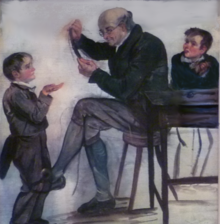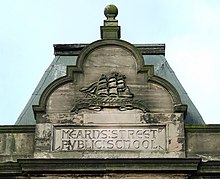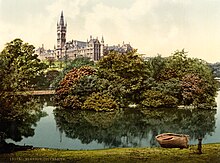Scottish education in the nineteenth century
By the late seventeenth century there was a largely complete system of parish schools, but it was undermined by the Industrial Revolution and rapid urbanisation.
Scots played a major part in the development of teacher education with figures including William Watson, Thomas Guthrie, Andrew Bell, John Wood and David Stow.
The perceived problems and fragmentation of the Scottish school system led to a process of secularisation, as the state took increasing control.
In 1890 school fees were abolished, creating a state-funded, national system of compulsory free basic education with common examinations.
[2] By the eighteenth century many poorer girls were being taught in dame schools, informally set up by a widow or spinster to teach reading, sewing, and cooking.
[3] The Statistical Account of Scotland undertaken parish-by-parish by John Sinclair in the 1790s indicated that all but the oldest inhabitants were expected to be able to read and that many (although fewer girls) could write and count.
[5] The publication of George Lewis's Scotland: a Half Educated Nation in 1834 began a major debate on the suitability of the parish school system, particularly in rapidly expanding urban areas.
[9] The influx of large numbers of Irish immigrants in the nineteenth century led to the establishment of Catholic schools, particularly in the urban west of the country, beginning with Glasgow in 1817.
The ideas were taken up in Aberdeen where Sheriff William Watson founded the House of Industry and Refuge, and they were championed by Scottish minister Thomas Guthrie who wrote Plea for Ragged Schools (1847), after which they rapidly spread across Britain.
[15] Ultimately Wood's ideas played a greater role in the Scottish educational system as they fitted with the need for rapid expansion and low costs that resulted from the reforms of 1872.
[4] Scottish schoolmasters gained a reputation for strictness and frequent use of the tawse, a belt of horse hide split at one end that inflicted stinging punishment on the hands of pupils.
[16] The perceived problems and fragmentation of the Scottish school system led to a process of secularisation, as the state took increasing control.
[17] The 1861 Education Act removed the provision stating that Scottish teachers had to be members of the Church of Scotland or subscribe to the Westminster Confession.
The preferred method was to introduce vocational supplementary teaching in the elementary schools, later known as advanced divisions, up until the age of 14, when pupils would leave to find work.
[19] However, in the second half of the century roughly a quarter of university students can be described as having working class origins, largely from the skilled and independent sectors of the economy.
In 1890 school fees were abolished, creating a state-funded, national system of compulsory free basic education with common examinations.
[22] Although Scottish universities had gained a formidable reputation in the eighteenth century, particularly in areas like medicine and had produced leading scientists such as Joseph Black (1728–99), the curriculum was dominated by divinity and the law and there was a concerted attempt to modernise the curriculum, particularly by introducing degrees in the physical sciences and the need to reform the system to meet the needs of the emerging middle classes and the professions.
[23] It pioneered the admission of women to Scottish universities, creating the Lady Licentiate in Arts (LLA), which proved highly popular.
[21] Unlike the other Medieval and ecclesiastical foundations, the University of Edinburgh was the "tounis college", founded by the city after the Reformation, and was as a result relatively poor.
[23] The result of these reforms was a revitalisation of the Scottish university system, which expanded to 6,254 students by the end of the century[21] and produced leading figures in both the arts and sciences.
[23] At Edinburgh, major figures included David Brewster (1781–1868), who made contributions to the science of optics and to the development of photography.
Fleeming Jenkin (1833–85) was the first professor of engineering at the university and among wide interests helped develop ocean telegraphs and mechanical drawing.
[28][29] Major figures to emerge from Scottish universities in the science of humanity included the philosopher Edward Caird (1835–1908), the anthropologist James George Frazer (1854–1941) and the sociologist and urban planner Patrick Geddes (1854–1932).






